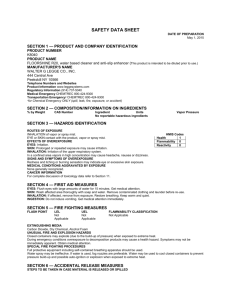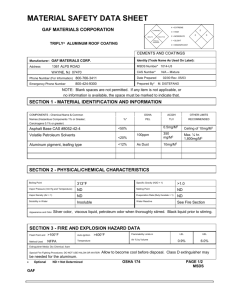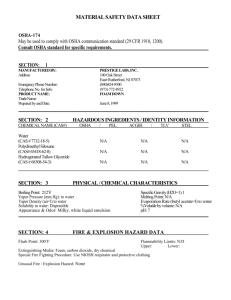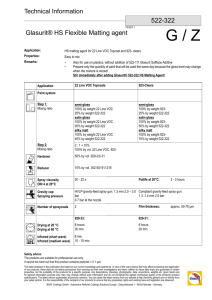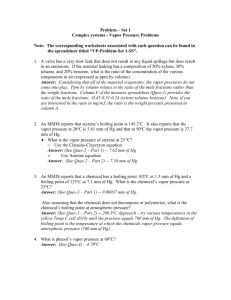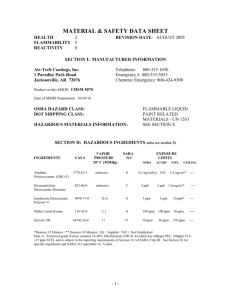PNEAC Fact Sheets-How to Read & Use an MSDS
advertisement
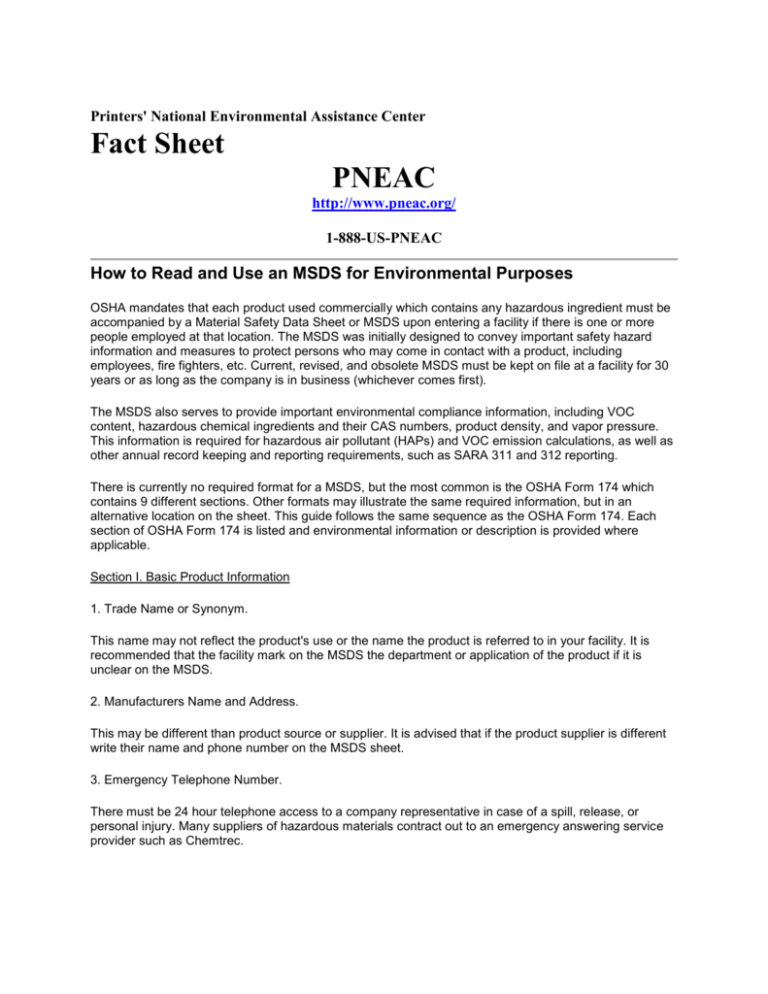
Printers' National Environmental Assistance Center Fact Sheet PNEAC http://www.pneac.org/ 1-888-US-PNEAC How to Read and Use an MSDS for Environmental Purposes OSHA mandates that each product used commercially which contains any hazardous ingredient must be accompanied by a Material Safety Data Sheet or MSDS upon entering a facility if there is one or more people employed at that location. The MSDS was initially designed to convey important safety hazard information and measures to protect persons who may come in contact with a product, including employees, fire fighters, etc. Current, revised, and obsolete MSDS must be kept on file at a facility for 30 years or as long as the company is in business (whichever comes first). The MSDS also serves to provide important environmental compliance information, including VOC content, hazardous chemical ingredients and their CAS numbers, product density, and vapor pressure. This information is required for hazardous air pollutant (HAPs) and VOC emission calculations, as well as other annual record keeping and reporting requirements, such as SARA 311 and 312 reporting. There is currently no required format for a MSDS, but the most common is the OSHA Form 174 which contains 9 different sections. Other formats may illustrate the same required information, but in an alternative location on the sheet. This guide follows the same sequence as the OSHA Form 174. Each section of OSHA Form 174 is listed and environmental information or description is provided where applicable. Section I. Basic Product Information 1. Trade Name or Synonym. This name may not reflect the product's use or the name the product is referred to in your facility. It is recommended that the facility mark on the MSDS the department or application of the product if it is unclear on the MSDS. 2. Manufacturers Name and Address. This may be different than product source or supplier. It is advised that if the product supplier is different write their name and phone number on the MSDS sheet. 3. Emergency Telephone Number. There must be 24 hour telephone access to a company representative in case of a spill, release, or personal injury. Many suppliers of hazardous materials contract out to an emergency answering service provider such as Chemtrec. 4. Chemical Name of Product. Refers only to products that are single substances, such as methyl ethyl ketone. This information may be omitted if the product is a mixture or proprietary. 5. Date Prepared. Signifies the date the original MSDS information was compiled or last updated. This information should be used to verify whether a new MSDS has been updated or is a duplicate of current MSDS on file. 6. Signature of Preparer. Optional information, name and/or signature of the person who prepared the MSDS. Section II: Hazardous Ingredients This section lists the chemical name, CAS (chemical abstract service) number, and the quantity of the chemical within the product expressed in percent by volume or weight. This information is needed to calculate the chemical usage and storage quantities for SARA Section 311, 312, and 313 compliance as well as calculating HAPs and VOC emissions from the product for air permitting calculations or quantity of chemical released. Some state air operating permits specify how the VOC information must be calculated and the printer may need to work with the supplier to provide the VOC information in the correct units of measure. Many MSDS omit the VOC containing products in this section, but will list the total volatile content of the product. The printer will need to consult the supplier to obtain a product data sheet which provides information about the actual chemical and its concentration that is a VOC. A supplier may list chemical content as a range due to proprietary concerns, for example 10-15%. In this case the printer should verify the VOC content with the product supplier. If the actual VOC content cannot be verified, consider the higher percentage when calculating total concentration of VOC or HAP. VOC emission calculations and certification that the information is correct is the responsibility of the printer. In other words it is the printer's responsibility to verify that the VOC information that the supplier provided is correct. One way to assure that the information is correct is to request that the supplier determine the VOC content of their products through EPA Test Method 24 or Method 24A, which are analysis protocols for determining VOC content of liquids established by U.S. EPA. Section III: Physical Data 1. Boiling Point: The temperature in degrees F at which a liquid boils under normal atmospheric conditions. 2. Vapor Pressure: The pressure of saturated vapor above the liquid in mercury at 68 degrees F. Boiling point (bp) and vapor pressure (vp) indicate how rapidly the material evaporates or how much VOC and HAPs are in the product. For example, Isopropyl alcohol has a boiling point of 180 degrees F and a vapor pressure of 33 mm Hg. Where as ethylene glycol has a bp of 379 degrees F and a vp of 0.1 mm Hg. Products with a low boiling point, vapor pressure and vapor density typically are high VOC products. Some state air regulations limit the vapor pressure of certain printing products, such as blanket wash or fountain solution (used in offset printing). When considering alternative products in order to reduce VOC emissions, the vapor pressure of a solution is a key factor. It is best to select products with low VOC and no or low HAP content and/or products with a vapor pressure of 10mm Hg at 20 C or less. A product which contains 100% VOC, but has a vapor press of 10mm of Hg at 70 at 20 C will emit approximately 30% VOC's by weight because the product does not evaporate as quickly. 3. Vapor Density: The weight of a vapor or gas compared with an equal volume of air measured at 60-90 degrees F. Vapor density indicates whether the vapor is heavier or lighter than air. With flammable materials, when the vapor density is greater than one, vapors will tend to move or collect in a low spot. Flame sources should be carefully controlled or avoided in these areas. For example the vapor density of isopropyl alcohol is 2.07, propane is 1.52, and helium is 0.1114; which means IPA and propane are an immediate fire hazard because the gas can collect in low spots within a building and easily ignite. 4. Solubility in Water: Indicates how quickly the material combines with distilled water at 50 F. It is measured in the following terms: Negligible - less than 0.1% Slight - 0.1 to 1% Moderate - 1 to 10% Appreciable - more than 10% Complete - in all proportions 5. Specific Gravity This is the ratio of the density of a material to the density of water. In other words, it compares the weight of water to the weight of material. This information is especially important in the event of a spill which can reach a lake or stream. 6. Evaporation Rate This the rate the material evaporates compared to either butyl acetate or ethyl ether. 7. Appearance and Odor A brief description of the material. Ex. viscous colored liquid with ammonia odor. 8. Percent Volatile by Weight This information may not be included (required on old format); the printer may need to ask the supplier in writing, to include this information on all MSDS or provide a product data sheet. This is the total VOC content of the product. This number should correspond with the sum of the VOC products listed in Section II. This number should be used to calculate the total VOC emissions of the product. This is calculated by multiplying the total pounds of material by the %VOC content listed (or gal product x density x %VOC). Some state air regulations limit the VOC content of products commonly used by printers. For SARA reporting purposes each reportable chemical listed, the printer must calculate the amount consumed or stored on site by the % content listed in the health hazard section. The total amount (in all mixtures and pure form) stored or consumed on site must then be compared to the reporting limit. If the reporting limit for any "listed" chemical is less than what was consumed or stored on site during any month or calendar year reporting requirements may apply. Section IV: Fire and Explosion Data 1. Flash Point The minimum temperature in degrees fahrenheit, at which a liquid gives off enough vapor for the material to auto ignite. The most common test method is the closed cup method. 2. Flammable or Explosive Limits The range of gas or vapor concentrations (percent by volume in air) which will burn or explode if an ignition source is present. This is expressed as the lower explosion limit or LEL and the upper explosion limit or UEL. 3. Extinguishing Media Lists the firefighting media suitable for use on the burning material. Some chemicals may negatively react to water which is the most common extinguishing media. Therefore alternative methods, such as carbon dioxide may be more suitable for extinguishing the flames. 4. Special Fire Fighting Procedures This includes information about the toxicity of combustion products, any special personal protective equipment, etc. 5. Unusual Fire and Explosion Hazards This describes any special potential hazards which may need attention. For example, if water is improperly applied to a flammable liquid with a flash point greater than 212 F, a violent boiling reaction could occur. Section V. Reactivity Data 1. Stability Indicates whether a chemical is stable or unstable under reasonably foreseeable conditions of storage, use or misuse. If unstable, the potential reactions will be listed. 2. Incompatibility Lists chemicals and compounds that will negatively react with the product and should not be combined or stored. This is important to review prior to use and/or disposal. Shop towels and waste storage containers are one of the more common areas where incompatible materials are inadvertently combined and a negative reaction occurs. 3. Hazardous Decomposition or By-Products Describes the products produced as a result of heating, burning or oxidizing. For example, thermal decomposition of vinyl chloride plastics produces carbon monoxide (CO), carbon dioxide (CO2) and hydrochloric acid (HCl) 4. Hazardous Polymerization Describes the products that may be produced as a result of combining/exposing incompatible products. For example combining chlorine (bleach) with ammonia will produce hydrochloric acid. Section VI. Health Hazard Data 1. Routes of Entry Ways the material could enter the body. 2. Health Hazards (acute and chronic) Potential over exposure affects that will dissipate when moved away from product (acute) and potential health affects resulting from repeated, long term overexposure which leads to symptoms that remain fom greater than a few minutes/hours (chronic). 3. Carcinogenicity Indicates whether or not the product is known or suspect cause of cancer. 4. Signs/symptoms of Exposure 5. Medical conditions generally aggravated by exposure Lists potential medical conditions which will worsen as a result of exposure to this product. 6. Emergency and First Aid Procedures. Recommendations on how to treat victims of over exposure. Section VII: Spill and Leak Procedures 1. Steps to be taken in case material is released or spilled Describes special precautions if the material is spilled, such as evacuate area. 2. Waste Disposal Method This area rarely describes how the product should be disposed of because each state and local government's waste disposal regulations may be different. Check with the supplier and review your state and local ordinances for proper disposal methods. Additionally, review waste water discharge permits prior to flushing any product down any drain. 3. Precautions to be taken in handling and storing. Provides information such as recommendations for temperature control, light exposure, etc. which should be followed to avoid product degradation. 4. Other Precautions Section VIII: Control Measures 1. Respiratory Protection Specifies necessary protection to avoid inhalation overexposure. 2. Ventilation Indicatestype of ventilation needed to avoid overexposure. 3. Protective Gloves/eye protection/other equipment Specifies the type of eye, hand and/or body protection that should be used while handling product. 4. Other Protective Clothing or Equipment Includes additional recommended protective garments not covered in #3. 5. Work/Hygienic Practices Provides information regarding personal handling such as washing hands prior to consuming food or beverage, etc.
